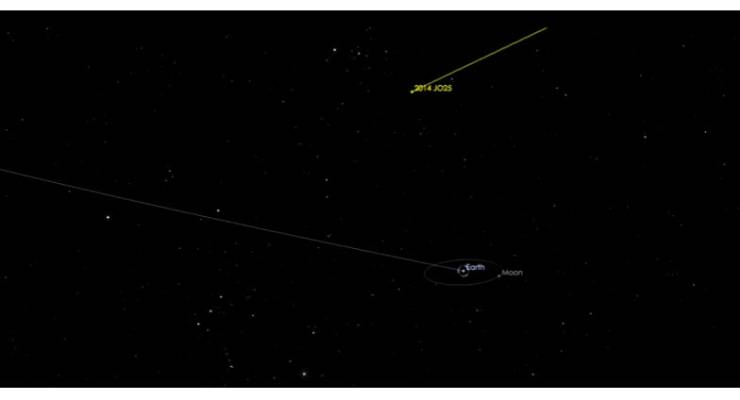
Animation from the NASA Jet Propulsion Laboratory
It’s not going to be the end of the world, and it won’t even be naked eye visible, but sky-gazers and astronomers worldwide are gearing up for a close encounter with non-killer asteroid 2014 JO25 on April 19.
This mysterious (as in, little known) space rock is coming at planet Earth from the direction of the Sun, and won’t be well enough separated in the sky from its glare until it gets as close as 4.6 times the nominal distance of the Moon on that night.
It could be 1400 metres wide (or long), although most estimates are for 600 metres in diameter, and whatever it is made of makes it twice as reflective as the surface of the Moon.
But when it was discovered by the US-funded Catalina Sky Survey in 2014, enough was learned about its orbit to make accurate reconstructions of its movements for the previous 400 years, and predictions for the next 500 years.
This led to it being classified as a “potentially hazardous object” by the Minor Planet Centre, which uses the space sentry sky patrols of watchers like those of the Catalina Survey to pick up asteroids or comets that can get close enough to Earth to risk a future direct collision.
JO25, which is in desperate need of a popular name, is going to be readily visible for as long as two nights to sky-gazers with a reasonably good amateur telescope as a northern sky object from Australian latitudes, and a much higher-in-the-sky target in the northern hemisphere.
[Don’t look now, but scientists might have just discovered evidence of alien spaceships]
At its apparent fastest motion against the backdrop of the cosmos, it will cover about half a degree or the apparent width of the Moon, every 18 minutes, meaning it will be seen as a noticeably moving star using the right telescopes and electrically powered tracking mounts. (More technical tracking advice can be found here).
Joe 25, as we might call it, is something the sky sentry programs were set up to find and flag, because while asteroids like Joe mightn’t be big enough to wipe out the dinosaurs of the past, they pack enough kinetic energy to incinerate whole cities.
With a few decades’ notice, such objects might be deflected if ever found to be on a collision course with Earth. Or if Joe 25 had been found in 2014 with only a few days notice of an impact, time enough for Plan B, which is a “run for your lives” warning for anyone within maybe 1000 kilometres of ground zero.
Consider this: on February 15, 2013, dash cams in cars all over Russia’s southern Urals saw a 20-metre wide meteorite explode in a fireball over Chelyabinsk, causing an air blast that injured at least 1500 people and even brought down some older buildings. In cosmic terms, the Chelyabinsk object was a wafer thin distance closer to its entanglement with Earth’s gravitational field than next week’s intruder from space, and Joe is at least 30 times wider and thus possibly more than hundreds of times more massive than it was.








Ben, mass scales as the cube of linear dimensions. If it is 30 times larger it is 30x30x30 =27,000 times heavier – assuming the same density.
No worries, the Drumpster can send Bruce Willis on a Tomahawk missile to deal with it.